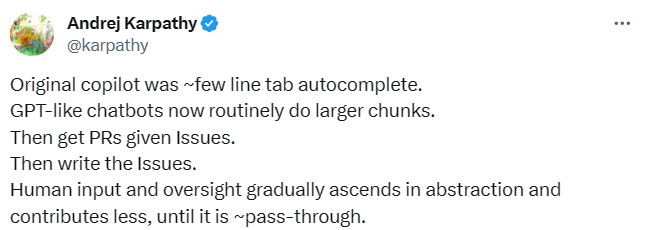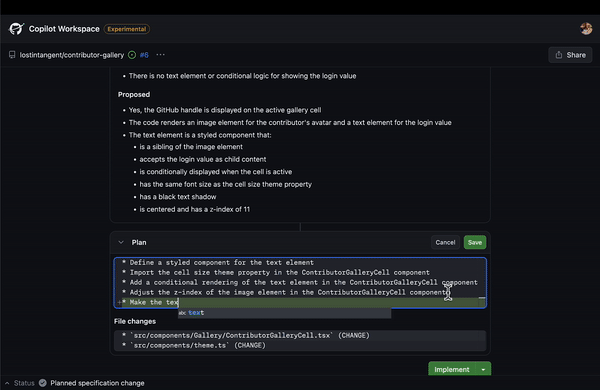 Technology peripherals
Technology peripherals
 AI
AI
 Developers' 'second brain” is coming, GitHub Copilot is updated, and human development participation is further reduced
Developers' 'second brain” is coming, GitHub Copilot is updated, and human development participation is further reduced
Developers' 'second brain” is coming, GitHub Copilot is updated, and human development participation is further reduced

What makes Andrej Karpathy lament that the contribution of humans in directly writing code in the software development process will become smaller and smaller, and the role of direct input and supervision will become more abstract. Eventually, the role of humans will simply be to do basic review and validation, rather than being the primary programmer and developer.
It turns out to be GitHub’s newly released Copilot Workspace, which reimagines developers’ internal processes. If AI development tools are developers’ second pair of hands, then Copilot Workspace will be developers’ “second brain.”
In the process of coding, the most troublesome thing is encountering an unfamiliar software warehouse, programming language or framework. The difficulty caused by solving these problems may delay your completion of the task, or even make it impossible to complete it at all. It's not easy to master these quickly and get back on your feet within the time limit. But Copilot Workspace may be able to help you get twice the result with half the effort, and even help you complete larger and more complex tasks.
Copilot Workspace, your “second brain”
Copilot Workspace focuses on task selection, intention expression and working with AI to find solutions plan. The aim is to reduce complexity and increase productivity, while also maintaining important aspects of software development such as decision-making and creativity and autonomy.
You can ask Copilot Workspace a question and it will automatically suggest a solution. Copilot Workspace has the full context of the issue (including all comments and replies) and the code base, so it understands both what you want to do and what exactly your code is about. If the solution proposed by Copilot Workspace isn't quite right, you can edit any step in the process, from actions to plans to code, all in natural language.

Copilot Workspace answers GitHub questions

In the editing process Steps to make adjustments
Copilot Workspace operates at the granularity of the entire software package and enables coherent modification of multiple files across different programming languages. It can handle both core coding tasks and scaffolding-type tasks, such as "Building a test framework" or "Writing GitHub Actions workflows for continuous integration." It is already used in GitHub Next for development of Copilot Workspace itself and other projects.
Task-centric workflow
Copilot Workspace can help developers complete complete development tasks, which are usually based on GitHub issues. Form specification and tracking. Therefore, Copilot Workspace can take a problem as input, automatically extract the current behavior of the code, propose a new behavior that solves the problem, develop a plan, and implement the plan (that is, write the code). Copilot Workspace has the full context of an issue, including all comments, and can even follow links within the issue to extract information to help complete tasks.
User feedback and iteration are what Copilot Workspace focuses on. You can edit every step of the process, from suggested new actions to planning and implementation. For example, after you implement a plan and see the code, you can go back and adjust the behavior or plan and try again. You can even open the same question in multiple tabs to explore several different paths.
Usage Demonstration
Previous attempts to use LLM to complete developer tasks focused mainly on dialogue, but Copilot Workspace has a more task-based user interface It is more structured and has obvious advantages:
- 1. Copilot Workspace can fully understand the ins and outs of the problem and come up with the right solution.
- 2. Structured output (original and modified actions, plans, and implementations) allows users to easily guide Copilot Workspace at the appropriate level of abstraction.
Currently, Copilot Workspace uses GitHub issues as a starting point, but there are plans to support additional entry points in the future. For example, Copilot Workspace can help developers handle security alerts discovered through CodeQL, migrate to new versions of dependent libraries or from one library to another, and resolve comments in PR reviews.
Cloud-driven agents
GitHub combines AI agent technology and GitHub Codespaces to achieve headless, ephemeral, and secure computing. When the user clicks the "Run" button, a new codespace will be created in the background, the modified code will be pushed into it, and an attempt will be made to build the project. If the build fails, we feed the error message and code back to Copilot Workspace and ask it to fix the build. Once the build is successful, the modified code is synced back to the Copilot Workspace user interface, allowing users to see how the build was fixed. If the running project is a web application, the port on the codespace will be forwarded to a URL that only that user can access. Users can click and view a live preview of the web application to visually verify that Copilot Workspace is performing as they expect.
Because large language models (LLMs) are not perfect, the "last mile" of many tasks is very important. Copilot Workspace allows you to open a codespace and continue where you left off, completing tasks in a full cloud IDE with a secure runtime.
Designed for collaboration
Copilot Workspace makes it easy to share workspaces by just clicking the Share button. Because the user experience is structured, it captures the entire activity log of a session, which is also a great way to understand why your implementation works the way it does. You can view the plan, watch each step of the implementation, and navigate to the corresponding code changes by clicking on the plan step in the user interface. This enriches the code review format, where code differences and their causes are clearly visible.
GitHub plans to add commenting and multi-person editing capabilities, and Copilot Workspace will be able to handle both in-developer and review loops in one tool.
The above is the detailed content of Developers' 'second brain” is coming, GitHub Copilot is updated, and human development participation is further reduced. For more information, please follow other related articles on the PHP Chinese website!

Hot AI Tools

Undresser.AI Undress
AI-powered app for creating realistic nude photos

AI Clothes Remover
Online AI tool for removing clothes from photos.

Undress AI Tool
Undress images for free

Clothoff.io
AI clothes remover

AI Hentai Generator
Generate AI Hentai for free.

Hot Article

Hot Tools

Notepad++7.3.1
Easy-to-use and free code editor

SublimeText3 Chinese version
Chinese version, very easy to use

Zend Studio 13.0.1
Powerful PHP integrated development environment

Dreamweaver CS6
Visual web development tools

SublimeText3 Mac version
God-level code editing software (SublimeText3)

Hot Topics
 1379
1379
 52
52
 Open source! Beyond ZoeDepth! DepthFM: Fast and accurate monocular depth estimation!
Apr 03, 2024 pm 12:04 PM
Open source! Beyond ZoeDepth! DepthFM: Fast and accurate monocular depth estimation!
Apr 03, 2024 pm 12:04 PM
0.What does this article do? We propose DepthFM: a versatile and fast state-of-the-art generative monocular depth estimation model. In addition to traditional depth estimation tasks, DepthFM also demonstrates state-of-the-art capabilities in downstream tasks such as depth inpainting. DepthFM is efficient and can synthesize depth maps within a few inference steps. Let’s read about this work together ~ 1. Paper information title: DepthFM: FastMonocularDepthEstimationwithFlowMatching Author: MingGui, JohannesS.Fischer, UlrichPrestel, PingchuanMa, Dmytr
 The world's most powerful open source MoE model is here, with Chinese capabilities comparable to GPT-4, and the price is only nearly one percent of GPT-4-Turbo
May 07, 2024 pm 04:13 PM
The world's most powerful open source MoE model is here, with Chinese capabilities comparable to GPT-4, and the price is only nearly one percent of GPT-4-Turbo
May 07, 2024 pm 04:13 PM
Imagine an artificial intelligence model that not only has the ability to surpass traditional computing, but also achieves more efficient performance at a lower cost. This is not science fiction, DeepSeek-V2[1], the world’s most powerful open source MoE model is here. DeepSeek-V2 is a powerful mixture of experts (MoE) language model with the characteristics of economical training and efficient inference. It consists of 236B parameters, 21B of which are used to activate each marker. Compared with DeepSeek67B, DeepSeek-V2 has stronger performance, while saving 42.5% of training costs, reducing KV cache by 93.3%, and increasing the maximum generation throughput to 5.76 times. DeepSeek is a company exploring general artificial intelligence
 AI subverts mathematical research! Fields Medal winner and Chinese-American mathematician led 11 top-ranked papers | Liked by Terence Tao
Apr 09, 2024 am 11:52 AM
AI subverts mathematical research! Fields Medal winner and Chinese-American mathematician led 11 top-ranked papers | Liked by Terence Tao
Apr 09, 2024 am 11:52 AM
AI is indeed changing mathematics. Recently, Tao Zhexuan, who has been paying close attention to this issue, forwarded the latest issue of "Bulletin of the American Mathematical Society" (Bulletin of the American Mathematical Society). Focusing on the topic "Will machines change mathematics?", many mathematicians expressed their opinions. The whole process was full of sparks, hardcore and exciting. The author has a strong lineup, including Fields Medal winner Akshay Venkatesh, Chinese mathematician Zheng Lejun, NYU computer scientist Ernest Davis and many other well-known scholars in the industry. The world of AI has changed dramatically. You know, many of these articles were submitted a year ago.
 Hello, electric Atlas! Boston Dynamics robot comes back to life, 180-degree weird moves scare Musk
Apr 18, 2024 pm 07:58 PM
Hello, electric Atlas! Boston Dynamics robot comes back to life, 180-degree weird moves scare Musk
Apr 18, 2024 pm 07:58 PM
Boston Dynamics Atlas officially enters the era of electric robots! Yesterday, the hydraulic Atlas just "tearfully" withdrew from the stage of history. Today, Boston Dynamics announced that the electric Atlas is on the job. It seems that in the field of commercial humanoid robots, Boston Dynamics is determined to compete with Tesla. After the new video was released, it had already been viewed by more than one million people in just ten hours. The old people leave and new roles appear. This is a historical necessity. There is no doubt that this year is the explosive year of humanoid robots. Netizens commented: The advancement of robots has made this year's opening ceremony look like a human, and the degree of freedom is far greater than that of humans. But is this really not a horror movie? At the beginning of the video, Atlas is lying calmly on the ground, seemingly on his back. What follows is jaw-dropping
 KAN, which replaces MLP, has been extended to convolution by open source projects
Jun 01, 2024 pm 10:03 PM
KAN, which replaces MLP, has been extended to convolution by open source projects
Jun 01, 2024 pm 10:03 PM
Earlier this month, researchers from MIT and other institutions proposed a very promising alternative to MLP - KAN. KAN outperforms MLP in terms of accuracy and interpretability. And it can outperform MLP running with a larger number of parameters with a very small number of parameters. For example, the authors stated that they used KAN to reproduce DeepMind's results with a smaller network and a higher degree of automation. Specifically, DeepMind's MLP has about 300,000 parameters, while KAN only has about 200 parameters. KAN has a strong mathematical foundation like MLP. MLP is based on the universal approximation theorem, while KAN is based on the Kolmogorov-Arnold representation theorem. As shown in the figure below, KAN has
 Kuaishou version of Sora 'Ke Ling' is open for testing: generates over 120s video, understands physics better, and can accurately model complex movements
Jun 11, 2024 am 09:51 AM
Kuaishou version of Sora 'Ke Ling' is open for testing: generates over 120s video, understands physics better, and can accurately model complex movements
Jun 11, 2024 am 09:51 AM
What? Is Zootopia brought into reality by domestic AI? Exposed together with the video is a new large-scale domestic video generation model called "Keling". Sora uses a similar technical route and combines a number of self-developed technological innovations to produce videos that not only have large and reasonable movements, but also simulate the characteristics of the physical world and have strong conceptual combination capabilities and imagination. According to the data, Keling supports the generation of ultra-long videos of up to 2 minutes at 30fps, with resolutions up to 1080p, and supports multiple aspect ratios. Another important point is that Keling is not a demo or video result demonstration released by the laboratory, but a product-level application launched by Kuaishou, a leading player in the short video field. Moreover, the main focus is to be pragmatic, not to write blank checks, and to go online as soon as it is released. The large model of Ke Ling is already available in Kuaiying.
 The vitality of super intelligence awakens! But with the arrival of self-updating AI, mothers no longer have to worry about data bottlenecks
Apr 29, 2024 pm 06:55 PM
The vitality of super intelligence awakens! But with the arrival of self-updating AI, mothers no longer have to worry about data bottlenecks
Apr 29, 2024 pm 06:55 PM
I cry to death. The world is madly building big models. The data on the Internet is not enough. It is not enough at all. The training model looks like "The Hunger Games", and AI researchers around the world are worrying about how to feed these data voracious eaters. This problem is particularly prominent in multi-modal tasks. At a time when nothing could be done, a start-up team from the Department of Renmin University of China used its own new model to become the first in China to make "model-generated data feed itself" a reality. Moreover, it is a two-pronged approach on the understanding side and the generation side. Both sides can generate high-quality, multi-modal new data and provide data feedback to the model itself. What is a model? Awaker 1.0, a large multi-modal model that just appeared on the Zhongguancun Forum. Who is the team? Sophon engine. Founded by Gao Yizhao, a doctoral student at Renmin University’s Hillhouse School of Artificial Intelligence.
 Tesla robots work in factories, Musk: The degree of freedom of hands will reach 22 this year!
May 06, 2024 pm 04:13 PM
Tesla robots work in factories, Musk: The degree of freedom of hands will reach 22 this year!
May 06, 2024 pm 04:13 PM
The latest video of Tesla's robot Optimus is released, and it can already work in the factory. At normal speed, it sorts batteries (Tesla's 4680 batteries) like this: The official also released what it looks like at 20x speed - on a small "workstation", picking and picking and picking: This time it is released One of the highlights of the video is that Optimus completes this work in the factory, completely autonomously, without human intervention throughout the process. And from the perspective of Optimus, it can also pick up and place the crooked battery, focusing on automatic error correction: Regarding Optimus's hand, NVIDIA scientist Jim Fan gave a high evaluation: Optimus's hand is the world's five-fingered robot. One of the most dexterous. Its hands are not only tactile



